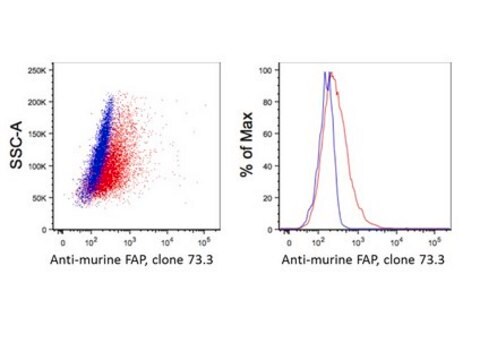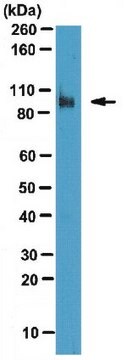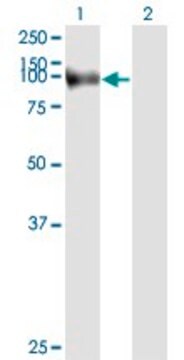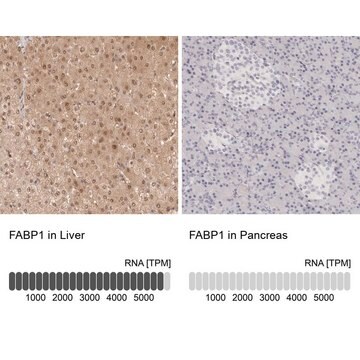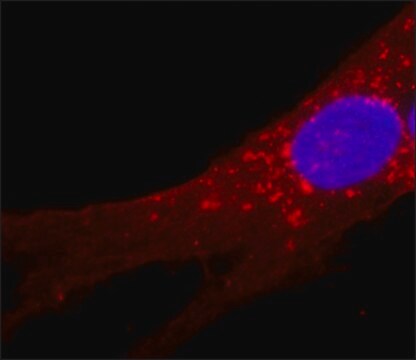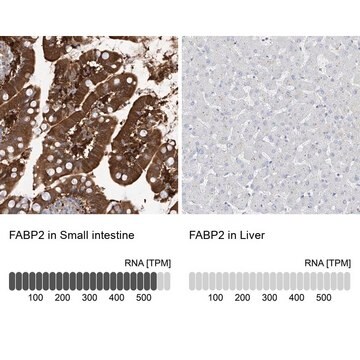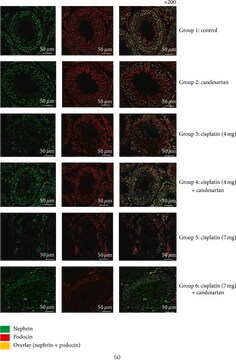SAB2900181
Anti-FAP (AB1) antibody produced in rabbit
affinity isolated antibody, buffered aqueous solution
同義詞:
170-kDa melanoma membrane-bound gelatinase, FAP, FAP alpha, FAPA, Seprase, fibroblast activation protein, fibroblast activation protein alpha
登入查看組織和合約定價
全部照片(1)
About This Item
分類程式碼代碼:
12352203
NACRES:
NA.41
推薦產品
一般說明
FAP gene is localized on human chromosome 2q24.2.
Fibroblast activation protein (FAP) is a type II transmembrane serine protease and a cell surface antigen. It is present as a homodimeric integral protein with dipeptidyl peptidase IV like fold. FAP has an α/β-hydrolase domain and an eight-bladed β-propeller domain. It is not expressed in normal tissues. The protein is only expressed by activated fibroblasts in response to pathologic situations.
免疫原
Synthetic 18 amino acid peptide from extracellular domain of human FAP. Percent identity with other species by BLAST analysis: Human, Gorilla, Gibbon (100%); Monkey (94%); Bovine (89%); Marmoset (83%).
應用
Anti-FAP (AB1) antibody produced in rabbit has been used in immunohistochemistry.
生化/生理作用
Fibroblast activation protein (FAP) is expressed in several pathogenic sites including cancer, fibrosis, arthritis, wounding, or inflammation. FAP has in vitro dipeptidyl peptidase activity and collagenolytic activity. It cleaves N-terminal dipeptides from polypeptides and can degrade gelatin and type I collagen.
特點和優勢
Evaluate our antibodies with complete peace of mind. If the antibody does not perform in your application, we will issue a full credit or replacement antibody. Learn more.
外觀
Solution in phosphate-buffered saline containing less than 0.1% sodium azide.
免責聲明
Unless otherwise stated in our catalog or other company documentation accompanying the product(s), our products are intended for research use only and are not to be used for any other purpose, which includes but is not limited to, unauthorized commercial uses, in vitro diagnostic uses, ex vivo or in vivo therapeutic uses or any type of consumption or application to humans or animals.
未找到適合的產品?
試用我們的產品選擇工具.
儲存類別代碼
10 - Combustible liquids
閃點(°F)
Not applicable
閃點(°C)
Not applicable
客戶也查看了
L Wagner et al.
Clinical and experimental immunology, 184(3), 265-283 (2015-12-17)
Dipeptidyl peptidase (DPP) 4 (CD26, DPP4) is a multi-functional protein involved in T cell activation by co-stimulation via its association with adenosine deaminase (ADA), caveolin-1, CARMA-1, CD45, mannose-6-phosphate/insulin growth factor-II receptor (M6P/IGFII-R) and C-X-C motif receptor 4 (CXC-R4). The proline-specific
Xuguang Yang et al.
Cancer research, 76(14), 4124-4135 (2016-05-25)
Cancer-associated fibroblasts (CAF) are components of the tumor microenvironment whose contributions to malignant progression are not fully understood. Here, we show that the fibroblast activation protein (FAP) triggers induction of a CAF subset with an inflammatory phenotype directed by STAT3
FAP Promotes Immunosuppression by Cancer-Associated Fibroblasts in the Tumor Microenvironment via STAT3?CCL2 Signaling
Xuguang Yang
Cancer Research (2016)
Structural and kinetic analysis of the substrate specificity of human fibroblast activation protein alpha
Kathleen Aertgeerts
The Journal of Biological Chemistry, 280 (2005)
Ellen Puré et al.
Oncogene, 37(32), 4343-4357 (2018-05-04)
Fibroblast activation protein (FAP) is a cell-surface serine protease that acts on various hormones and extracellular matrix components. FAP is highly upregulated in a wide variety of cancers, and is often used as a marker for pro-tumorigenic stroma. It has
我們的科學家團隊在所有研究領域都有豐富的經驗,包括生命科學、材料科學、化學合成、色譜、分析等.
聯絡技術服務